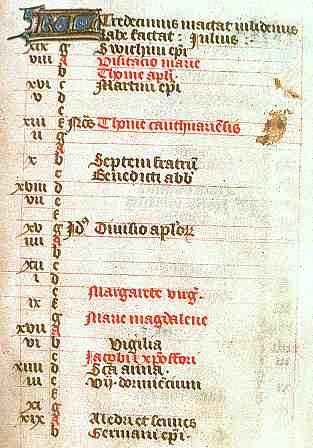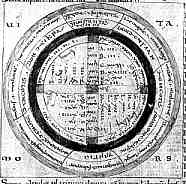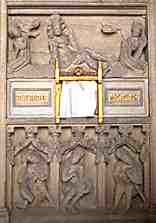 |
|
Reading
a Calendar (2) |
 |
Calendar
page from a 15th century book of hours produced in Flanders for the English
market (National Library of Australia MS 1097/9, f.4r), by permission of the
National Library of Australia. |
|
This
shows a fairly standard format for a late medieval calendar
page. The month is July. The more important festivals are entered in rubric,
and it can be seen that they include such general ones as the Visitation,
Thomas the apostle and Mary Magdalen. They also include St Thomas of Canterbury,
a saint with particular significance to the English. |
|
The
gold initials at the top of the page are KL
for kalens, the
first day of the month in the Roman calendar. On the 7th row of the actual
calendar, to the left of the rubric for St Thomas of Canterbury, the abbreviated
term Nos stands for nones,
the Roman dating term which refers to either the 5th or the 7th day, depending
on the month. On the 15th day the abbreviation Id
stands for ides. |
|
Down
the left are two rows, one of Roman numerals and the other of letters.
These are part of a fiendishly cunning method of calculating the date
of Easter in any given year. Concentrate carefully now. The numbers are
called the Golden
Numbers and every year has a Golden Number. To find the Golden Number
for any given year, take the number of the year, add 1, divide by 19 and
work out the remainder. If the remainder is 0 the Golden Number is 19.
eg.
for the year 1524 1524
+ 1 = 1525 1525 ÷ 19 = 80, remainder = 5 (Remember, they didn't have pocket calculators.) v
= Golden Number for 1524 The
letters, A to G constantly repeated, are called the Dominical
Letters and are used to identify the Sundays of any given year. Each
year has a Dominical Letter, and calculating it is real fun. The year
is added to a quarter of itself, with the remainder ignored; this sum
is divided by 7 and the remainder from this operation is subtracted from
3 or else from 10 in order to produce a positive integer. The number then
corresponds to a Dominical Letter. eg.
back to the year 1524 1524
+ (1524 ÷ 4) = 1524 + 381 = 1905 1905 ÷ 7 = 272, remainder = 1 3
- 1 = 2
2
= Dominical Letter B Right,
now we have the basic data with which to search our calendar. Easter must
fall on the first Sunday after the first full moon which follows the spring
equinox, which means that it can be no earlier than 22nd March and no later
than 25th April. The Golden Number represents the new moon, so we search for
that number between 1st March and April 12th, count forward 14 days to the
full moon, then look forward again to the next appearance of the Dominical
letter, and that date is Easter Sunday. Easter Sunday for 1524 was on 27th
March. |
|
Calculating
the date of Easter was a highly significant matter for the Christian church,
but the letters and numbers have a broader significance through the annual
cycle. The Golden Numbers effectively relate the lunar calendar to the solar
calendar throughout the year and the phases of the moon can be calculated
from them. The Dominical letters also indicate Sundays throughout the year. |
|
Some
books of hours
simplified the process by providing tables which gave the Golden Number
and the Dominical Letter for each year, for the benefit of patrons who
weren't so good at arithmetic, and even included the date of Easter for
each year. However, all this is an exposition rather than an explanation
and leaves a couple of important questions unanswered. How did they come
up with these arithmetical computations and why did they have such a complicated
system for working out when to hold their most important festival of the
year? |
|
Scholars
of the early Christian church devoted much time and energy to methods
of calculating the date of Easter, given it had to be held at the appointed
time in relation to the lunar calendar. The mode of calculation was subject
to various controversies, but was ultimately based on methods developed
in Alexandria where they were expert at astronomy. However, methods for
performing the actual computations were thrashed out in various works
known as computistical
texts. It was important to get it right because it had become a matter
of church authority to ensure that it was celebrated on the same date
throughout western Christendom. Great mental energy was expended on this
problem. |
|
|
Long
expositions, computations and esoteric complicated diagrams are found
in these works, such as this one from the late 11th century (British Library,
Cotton Caligula A XV, f.125v). By permission of the British Library. |
|
Why
they did it this way is based in history, symbolism and church authority.
In the very earliest days of the Christian church there had been a diversity
of practice in relation to the celebration of Easter among various branches
of the church. The short answer to the difficulty was that it was decided
at the Council of Nicea in 325 that Easter was to be celebrated on the Sunday
following the full moon after the spring equinox. This was by no means the
end of the story, as there were still divergent ways of actually computing
the date, but they eventually got it under control by the 6th century. |
|
The
reason for using the lunar calendar is based in the origins of Christianity
as an offshoot of the Jewish religion. The Jewish calendar was lunar, with
various untidy solutions to keep it synchronised with actual astronomical
events. The major feast of the Jewish calendar, the Passover or Pasch, at
which the paschal lamb was sacrificed, was calculated from this lunar calendar.
This ritual also required that the first fruits of the corn be brought to
the priests, so if it fell too early before the corn was ripe an extra month
was inserted to take it past the spring equinox. |
|
The
earliest Christians continued to follow the Jewish rituals and the symbolic
association of the sacrifice of the paschal lamb with the sacrifice of Christ,
the lamb of God, tied these two feasts together. However, at some stage and
not without divergences of practice, Sunday became the appropriate day for
celebrating the Resurrection of Christ, so that it was not celebrated on the
feast of the Pasch but on the first Sunday after. While the Christians eventually
developed their own method of computing the date, it was forever tied to its
origins in the Jewish faith. Its retention in a completely different calendrical
system to that used for everything else occurs to this day. |
|
|
The
Easter Sepulchre in Patrington church, Yorkshire, depicts the Resurrection
and was used in the rituals of Easter. |
|
|
 previous
page previous
page |
 Dating Manuscripts Dating Manuscripts |
 Why Read It? Why Read It? |
|
|
|
|
|


